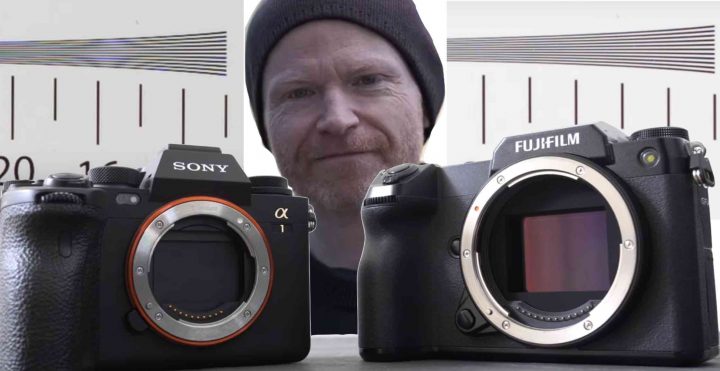Fujifilm GFX100S Cameralabs Review (vs Sony A1): A Tremendous, Inspirational and Satisfying Camera to Use

Gordon from Cameralabs reviewed the Fujifilm GFX100S.
Here is a summary of his 20 minutes long review and you’ll find also the video down below.
In short: it’s amazing!
- For GFX Lovers Only: the one and only Fujifilm GFX group
A more in depth comparison with the Sony A1 will follow, but some tidbits he already delivered in this review.
- Fujifilm GFX100S: BHphoto / AmazonUS / Adorama / Focuscamera / Moment
- Fujifilm GF80mmF1.7: BHphoto / AmazonUS / Adorama / Focuscamera / Moment
Summary
- same sensor of GFX100 in a much smaller and affordable body
- GFX100S marks the end of the GFX50S, which is now discontinued [Admin note: wrong, the reason is this one ;)]
- GFX100S is more affordable than Sony A1
- GFX100S feels in the hands like a Nikon D800 or Canon 5D
- it loses vertical grip over GFX100, but it’s smaller and retains weather sealing, grip, and IBIS
- NP-W235 battery used in Fujifilm X-T4 with 460 shots (CIPA rating)
- fixed EVF also helps to reduce size
- EVF has less resolution than GFX100
- he compared it to the Sony A1 viewfinder, which on paper has higher resolution.
- In use, the GFX100S viewfinder looks better than the specifications imply, perhaps because Fujifilm may be driving it in more modes at the full resolution than some rivals do
- he never felt the EVF held the camera back, including magnifying the view for precise manual focus or checking focus in playback
- 3 way tilt screen. Most owners will stay behind the camera anyway, so they won’t miss the selfie option
- PSAM dial. Switch stills/movie
- top LCD
- you can select up to 60 minutes shutter speed without having to enter bulb mode or use any cable release
- top LCD can be set to display a large histogram, virtual dials, or camera settings
- some of the buttons are small for a body this size
- he would have loved backlit buttons
- files are big, but you won’t shoot more than 5fps with this camera anyway and you are probably going to use it in more calm environments anyway
- mini HDMI input can output 12-bit ProRes RAW to a compatible recorder
- GF lenses offer a lot of quality, but there is more choice in for full frame bodies
- he loved most using the GF50mmF3.5. It transforms the GFX100S into a surprisingly compact and light system, that you can use almost everywhere for casual shooting and enjoy high quality results
- IBIS and phase detection increase your chances to get sharp results even handheld
- using the GF45mm, he could get reliably sharp results at 1/10th of a second
- for medium format, the AF speed is anything but normal
- for sports and wildlife, modern Sony and Canon cameras are better, and also eye-AF is more foolproof on those bodies. But for medium format, the GFX100S is impressively quick. it often feels like using a smaller format camera
- 66% larger sensor than full frame
- in lab test, the GFX100S easily out-resolves the Sony A1
- using pixel shift on the Sony A1, the resolution goes a tad beyond the one of the GFX100S, but it requires a tripod and static subject
- when used the GFX100S with pixel shift, it clearly outresolves the Sony A1 pixelshift
- JPEGs look great without any work
- GFX100S offers plenty of dynamic range
- in video, phase detection can hesitate from time to time. Fujifilm X series also have this behavior. Fujifilm can improve this via firmware
- Face and eye detection lacks of the ultimate confidence of latest Sony and Canon bodies, especially for maintaining focus on a subject that keeps moving and does not pause
- Fuji’s most compelling GFX medium format camera to date
- hugely detailed images with great out of camera quality we expect from Fujifilm
- of course GF lenses are larger and more expensive to accommodate the bigger sensor behind them, but with a GF50mmF3.5 it’s a surprisingly portable system capturing superior images to anything costing less than 10K.
- thanks to IBIS, you can take that full potential 100MP in fairly casual use
- 6K is expensive, but a relative bargain in the medium format world
- the GFX100S is fast for medium format, but if you need to shoot wildlife and sports, smaller formats are better
- there are 12 GF lenses, but full frame offers more choices
- GFX100S is for those who desire the best image quality and desire a different experience to full frame
- one of the most inspirational and satisfying cameras I’ve used for a long time
- if you have the budget, the GFX100S is simply a tremendous camera
- he looks forward to see how Fujifilm grows the system
Fujifilm GFX100S: BHphoto / AmazonUS / Adorama / Focuscamera / Moment
Fujinon GF80mmF1.7: BHphoto / AmazonUS / Adorama / Focuscamera / Moment
Follow FujiRumors on Patreon, Facebook, Instagram, RSS-feed, Youtube, Flipboard and Twitter

